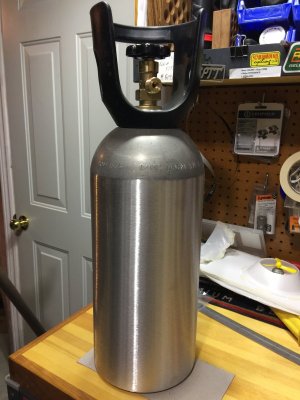I run around Glamis @10psi, its awesome. I also drive too and from each end of Glamis on the road (7-8miles) @10psi, I just keep it under 55-60. As previously mentioned its just gas mileage and a little tire wear. It is a little wallowee at that pressure. In the sand i'd go do deep in to the single digits if I needed to for a stuck situation (this is why my truck has beadlocks, Glamis sand and Baja silt). So far 10 psi is great though.... I used to run my old canam at 2psi in the sand, but that was race tires with beadlocks.
I've been running sub 15 psi on the street for years in between rock crawling trails. Its no big deal, just understand what you are doing.
As for CO2 vs. compressor, I'll join in what feels like the minority here. I've ran on both/all three (compressor, CO2, N2). I work in the gasses world and get tanks filled free with work. My experience is that I prefer the hard mounted compressor/reservoir, A proper setup will match a CO2 tank. I like the initial extra work to hide a compressor and tank in unused space and having a virtually unlimited air supply, no pneumatic tool freeze up, no refilling tanks, no hydro tests.
This is just my opinion. I ran on CO2 for more than 10 years and have switched back.
Fun fact Nissan used to include a "mini" CO2 tank with their new cars to fill up spare tires when you had a flat. They stopped providing these after people would overfill their tires and the CO2 would cause the tire to explode after heating up on the highway (CO2 is extremely temperature/pressure sensitive, this is one of the reasons it is filled/sold by the pound and not by pressure like other gasses). Nissan wanted our company at the time to dispose of those for them, these became my first air source. I'd bring a couple to the trail head each trip. Worked great.
I've been running sub 15 psi on the street for years in between rock crawling trails. Its no big deal, just understand what you are doing.
As for CO2 vs. compressor, I'll join in what feels like the minority here. I've ran on both/all three (compressor, CO2, N2). I work in the gasses world and get tanks filled free with work. My experience is that I prefer the hard mounted compressor/reservoir, A proper setup will match a CO2 tank. I like the initial extra work to hide a compressor and tank in unused space and having a virtually unlimited air supply, no pneumatic tool freeze up, no refilling tanks, no hydro tests.
This is just my opinion. I ran on CO2 for more than 10 years and have switched back.
Fun fact Nissan used to include a "mini" CO2 tank with their new cars to fill up spare tires when you had a flat. They stopped providing these after people would overfill their tires and the CO2 would cause the tire to explode after heating up on the highway (CO2 is extremely temperature/pressure sensitive, this is one of the reasons it is filled/sold by the pound and not by pressure like other gasses). Nissan wanted our company at the time to dispose of those for them, these became my first air source. I'd bring a couple to the trail head each trip. Worked great.


